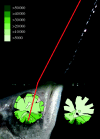A spitting image: specializations in archerfish eyes for vision at the interface between air and water
- PMID: 20392734
- PMCID: PMC2982040
- DOI: 10.1098/rspb.2010.0345
A spitting image: specializations in archerfish eyes for vision at the interface between air and water
Abstract
Archerfish are famous for spitting jets of water to capture terrestrial insects, a task that not only requires oral dexterity, but also the ability to detect small camouflaged prey against a visually complex background of overhanging foliage. Because detection of olfactory, auditory and tactile cues is diminished at air-water interfaces, archerfish must depend almost entirely on visual cues to mediate their sensory interactions with the aerial world. During spitting, their eyes remain below the water's surface and must adapt to the optical demands of both aquatic and aerial fields of view. These challenges suggest that archerfish eyes may be specially adapted to life at the interface between air and water. Using microspectrophotometry to characterize the spectral absorbance of photoreceptors, we find that archerfish have differentially tuned their rods and cones across their retina, correlated with spectral differences in aquatic and aerial fields of view. Spatial resolving power also differs for aquatic and aerial fields of view with maximum visual resolution (6.9 cycles per degree) aligned with their preferred spitting angle. These measurements provide insight into the functional significance of intraretinal variability in archerfish and infer intraretinal variability may be expected among surface fishes or vertebrates where different fields of view vary markedly.
Figures



Similar articles
-
A comparison of behavioural (Landolt C) and anatomical estimates of visual acuity in archerfish (Toxotes chatareus).Vision Res. 2013 May 3;83:1-8. doi: 10.1016/j.visres.2013.02.014. Epub 2013 Mar 1. Vision Res. 2013. PMID: 23466473
-
Visual acuity in the archerfish: behavior, anatomy, and neurophysiology.J Vis. 2012 Nov 28;12(12):18. doi: 10.1167/12.12.18. J Vis. 2012. PMID: 23197770
-
Archerfish vision: Visual challenges faced by a predator with a unique hunting technique.Semin Cell Dev Biol. 2020 Oct;106:53-60. doi: 10.1016/j.semcdb.2020.05.017. Epub 2020 Jun 7. Semin Cell Dev Biol. 2020. PMID: 32522409 Review.
-
Do American goldfinches see their world like passive prey foragers? A study on visual fields, retinal topography, and sensitivity of photoreceptors.Brain Behav Evol. 2014;83(3):181-98. doi: 10.1159/000357750. Epub 2014 Mar 24. Brain Behav Evol. 2014. PMID: 24663005
-
What a predator can teach us about visual processing: a lesson from the archerfish.Curr Opin Neurobiol. 2018 Oct;52:80-87. doi: 10.1016/j.conb.2018.04.001. Epub 2018 May 1. Curr Opin Neurobiol. 2018. PMID: 29727858 Review.
Cited by
-
Ecomorphology of eye shape and retinal topography in waterfowl (Aves: Anseriformes: Anatidae) with different foraging modes.J Comp Physiol A Neuroethol Sens Neural Behav Physiol. 2013 May;199(5):385-402. doi: 10.1007/s00359-013-0802-1. Epub 2013 Mar 10. J Comp Physiol A Neuroethol Sens Neural Behav Physiol. 2013. PMID: 23475299
-
Diurnal lighting patterns and habitat alter opsin expression and colour preferences in a killifish.Proc Biol Sci. 2013 May 22;280(1763):20130796. doi: 10.1098/rspb.2013.0796. Print 2013 Jul 22. Proc Biol Sci. 2013. PMID: 23698009 Free PMC article.
-
Axes of visual adaptation in the ecologically diverse family Cichlidae.Semin Cell Dev Biol. 2020 Oct;106:43-52. doi: 10.1016/j.semcdb.2020.04.015. Epub 2020 May 19. Semin Cell Dev Biol. 2020. PMID: 32439270 Free PMC article. Review.
-
Discrimination of human faces by archerfish (Toxotes chatareus).Sci Rep. 2016 Jun 7;6:27523. doi: 10.1038/srep27523. Sci Rep. 2016. PMID: 27272551 Free PMC article.
-
Eye movements of vertebrates and their relation to eye form and function.J Comp Physiol A Neuroethol Sens Neural Behav Physiol. 2015 Feb;201(2):195-214. doi: 10.1007/s00359-014-0964-5. Epub 2014 Nov 15. J Comp Physiol A Neuroethol Sens Neural Behav Physiol. 2015. PMID: 25398576 Review.
References
-
- Allison W. T., Haimberger T. J., Hawryshyn C. W., Temple S. E.2004Visual pigment composition in zebrafish: evidence for a rhodopsin–porphyropsin interchange system. Vis. Neurosci. 21, 945–952 - PubMed
-
- Barta A., Horvath G.2003Underwater binocular imaging of aerial objects versus the position of eyes relative to the flat water surface. J. Opt. Soc. Am. 20, 2370–2377 (doi:10.1364/JOSAA.20.002370) - DOI - PubMed
-
- Bekoff M., Dorr R.1976Predation by 'shooting' in archer fish, Toxotes jaculatrix: accuracy and sequences. Bull. Psychonom. Soc. 7, 167–168
-
- Bowmaker J. K.1977The visual pigments, oil droplets and spectral sensitivity of the pigeon. Vision Res. 17, 1129–1138 (doi:10.1016/0042-6989(77)90147-X) - DOI - PubMed
-
- Bowmaker J. K.1991The evolution of vertebrate visual pigments and photoreceptors. In Evolution of the eye and visual system, vol. 2 (eds Cronly-Dillon J. R., Gregory R. L.), pp. 63–81 Boca Raton, FL: CRC Press, Inc
Publication types
MeSH terms
Substances
LinkOut - more resources
Full Text Sources
Medical

